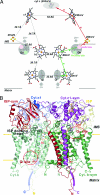Surface-modulated motion switch: capture and release of iron-sulfur protein in the cytochrome bc1 complex
- PMID: 16924113
- PMCID: PMC1551902
- DOI: 10.1073/pnas.0601149103
Surface-modulated motion switch: capture and release of iron-sulfur protein in the cytochrome bc1 complex
Abstract
In the cytochrome bc(1) complex, the swivel motion of the iron-sulfur protein (ISP) between two redox sites constitutes a key component of the mechanism that achieves the separation of the two electrons in a substrate molecule at the quinol oxidation (Q(o)) site. The question remaining is how the motion of ISP is controlled so that only one electron enters the thermodynamically favorable chain via ISP. An analysis of eight structures of mitochondrial bc(1) with bound Q(o) site inhibitors revealed that the presence of inhibitors causes a bidirectional repositioning of the cd1 helix in the cytochrome b subunit. As the cd1 helix forms a major part of the ISP binding crater, any positional shift of this helix modulates the ability of cytochrome b to bind ISP. The analysis also suggests a mechanism for reversal of the ISP fixation when the shape complementarity is significantly reduced after a positional reorientation of the reaction product quinone. The importance of shape complementarity in this mechanism was confirmed by functional studies of bc(1) mutants and by a structure determination of the bacterial form of bc(1). A mechanism for the high fidelity of the bifurcated electron transfer is proposed.
Conflict of interest statement
Conflict of interest statement: No conflicts declared.
Figures



References
-
- Trumpower B. L. J. Biol. Chem. 1990;265:11409–11412. - PubMed
-
- DiMauro S., Schon E. A. N. Engl. J. Med. 2003;348:2656–2668. - PubMed
-
- Staniek K., Gille L., Kozlov A. V., Nohl H. Free Radical Res. 2002;36:381–387. - PubMed
-
- Brasseur G., Saribas A. S., Daldal F. Biochim. Biophys. Acta. 1996;1275:61–69. - PubMed
-
- Bartlett D. W., Clough J. M., Godwin J. R., Hall A. A., Hamer M., Parr-Dobrzanski B. Pest Manag. Sci. 2002;58:649–662. - PubMed
Publication types
MeSH terms
Substances
Associated data
- Actions
- Actions
- Actions
- Actions
- Actions
- Actions
- Actions
- Actions
Grants and funding
LinkOut - more resources
Full Text Sources
Molecular Biology Databases
Research Materials

